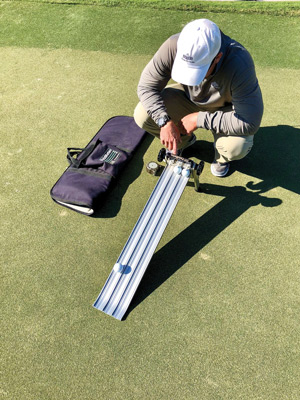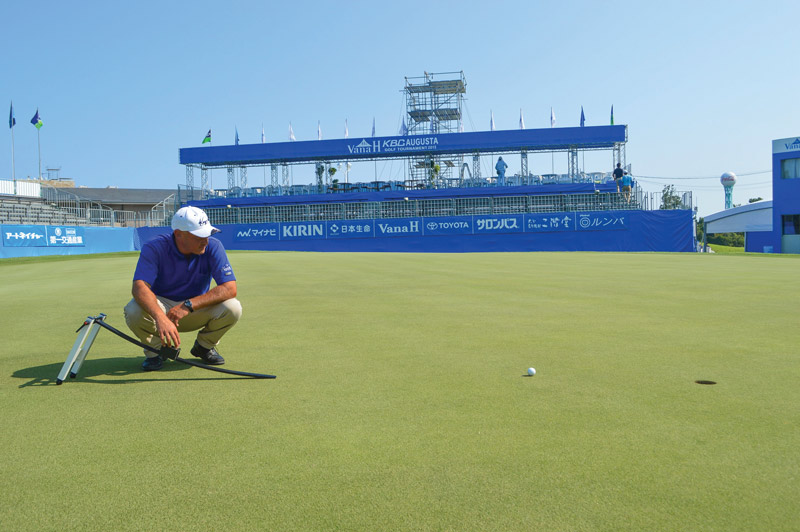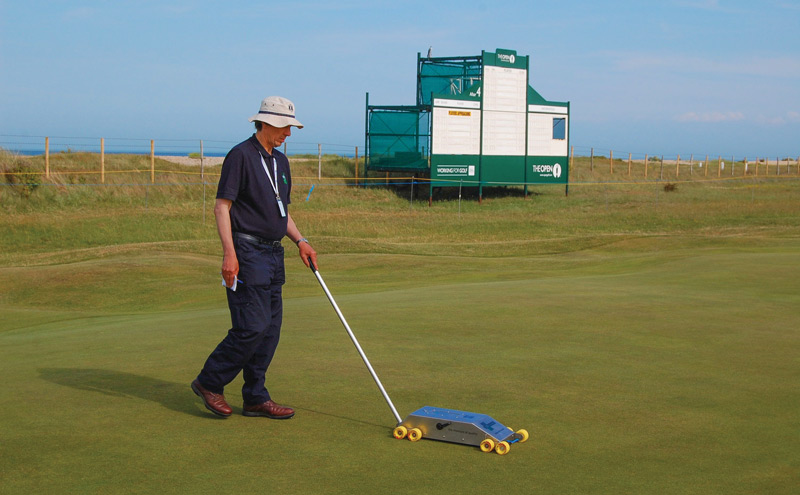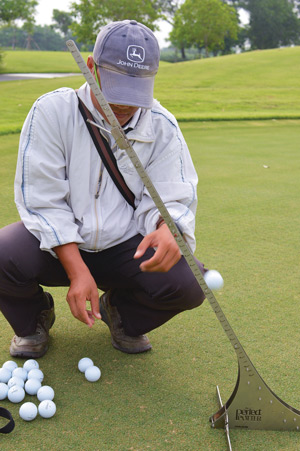
Figure 1. The USGA Stimpmeter in action, releasing the golf ball as the back end is elevated. For the “What the Tech?” authors, the Stimpmeter and other devices for measuring green speed tell a larger story about technology’s place in golf course management. Photo courtesy of Micah Woods
We wanted to begin this final installment of the “What the Tech?” series with a couple of thank-yous. First off, our sincere thanks to the folks at GCM for giving us the opportunity to talk tech — moisture meters, pin placement, putting green firmness and more — with you over the past few years. This series was born out of our recurring seminar at the Golf Industry Show (now the GCSAA Conference and Trade Show) called “Gadgets and Gizmos.” The original idea behind the seminar was that it might be beneficial for us to share with superintendents some of the technologies we were using in our research program.
What we quickly and regularly learned over the years was how much sharing is truly a two-way street. So many times, we were the ones who had a front-row seat to some wonderfully creative ideas coming from our audience members as to exactly how they were incorporating technology into their daily operations. So, a huge thank-you also to all the superintendents, assistants and everyone else who shared something with us during those seminars, as well as to those who have reached out in response to one of these “What the Tech?” articles. You all have contributed to this ever-evolving conversation of golf course technology and helped us see so much more than we could have imagined when we started.
And that’s more than just something we want to say thank you for; it’s the context for what we want to talk about here, in our final story. What we hope is one of the takeaways from this entire series is that technology is about more than just products — it’s about people and process. So often, conversations about technology focus exclusively on the devices (the gadgets and gizmos, if you will). But any device on its own is, at best, the potential for something useful. What makes technology work and what allows any device to have a meaningful impact ultimately depends not just on what it is, but on how it’s used and who is using it.
So, as we conclude this conversation about technology, we consider people and process, and we ask ourselves: What else do we need to cover when it comes to golf course technology? What numbers resonate? And how can we bring this massive concept of “technology” full circle and leave it in the proper perspective?
A green speed innovator
Thinking about all of those questions brought to mind Edward Stimpson, the Massachusetts Amateur champion who in the 1930s developed a device for assessing green speed. Some 40 years later, that device would be adopted by the USGA and had come to be known as the Stimpmeter (8) (Figure 1). Golfers the world over who couldn’t tell buffalograss from bentgrass if you gave them three guesses hang their agronomic knowledge and appraisal of course conditions on one number — Stimpson’s number.
So, we are talking about measurements that resonate, but Stimpson’s name came to mind because he also encapsulates the ingenuity and passion we’ve seen in so many superintendents and the in-house engineering they’ve brought to this area. Today, perceptions of the Stimpmeter and the number it produces have taken on a life of their own, but at its core, the measurement seeks to provide information on something fundamental and essential to the integrity of the game — how consistently the golf ball rolls across the putting surface.
If you ever attended one of our “Gadgets and Gizmos” seminars, you might have heard the story of a very prominent golfer who, several years back, had some less-than-flattering things to say about the Stimpmeter leading up to one of the major championships. He referred to it as “a stick created 71 years ago,” while contrasting that with the NASA-influenced pedigree of his alternative device, which he and his team were using to measure green speed (1).
When it came time to divvy up the prize money on that Sunday afternoon, that golfer was, well, at home, having shot +11 and failing to make the cut. To be fair, majors are hard, and that player is prominent because he has won plenty of times, before and after this episode. This story isn’t meant to take a swipe at anyone, but rather to make a larger point about technology. In this case, sophistication is no guarantee of success, and simplicity absolutely has a seat at the table.

Figure 2. A comparison of golf ball bounce upon exiting the Greenstester (top), Pelzmeter (middle) and Stimpmeter (bottom). Images courtesy of John McCalla
Something we’ve said before in this series bears repeating now: As technology continues to evolve, our ability to measure things is outpacing our understanding of exactly how to use all of these data points. Hopefully another one of the take-home messages from “What the Tech?” has been that the most valuable technologies are those that turn precise measurements into tangible actions.
There are a lot of numbers in the world, but some are more practical than others. The ability to distinguish between a measurable difference and a meaningful difference is a decision every superintendent has to make on their own.
Again, at the end of the day, the true benefits of technology reside in the hands of the people using it.
New methods for measuring green speed
When it comes to green speed and ball roll, the Stimpmeter is by no means the only game in town. There are other devices out there. Throughout the “Gadgets and Gizmos” era, we’ve had a lot of fun comparing the Stimpmeter with more recently developed alternatives such as the Pelzmeter and Greenstester (7). Like others who have carried out similar evaluations, we observed, through high-speed video, greater ball bounce for golf balls exiting the Stimpmeter as compared with the other devices (Figure 2, above).

Right: Figure 3. The Pelzmeter has a fixed, level base to its ramp, with controlled release of three golf balls within individual tracks. Photo courtesy of Darren Davis
During our seminars, this topic always seemed to generate lively discussion, with plenty of loyal supporters in all three camps. The Pelzmeter was designed with multidirectional leveling capabilities on its base and a more controlled release of the golf ball as a way of accounting for slope and introducing more consistency into the measurement process (Figure 3). The Greenstester features a flatter release point where the ramp meets the putting green, and it has an adjustable release point, allowing the ball to exit the ramp at differing velocities in order to replicate putts of various lengths (Figure 4).
With the Greenstester, we begin to see the notion of consistency being further developed into the concept of putting green trueness, which goes beyond simply measuring how far the ball travels and considers the outcome of each ball roll. Trueness is often evaluated through the holing-out test (5), where the Greenstester is set up in a location so that the ball goes into the hole. Ten golf balls are then rolled from that point, counting the total number that go in as an indicator of trueness. But to circle back to the idea of simplicity, one of the hall-of-fame videos from “Gadgets and Gizmos” is superintendent Jim Alwine’s version of the holing-out test with his 2-foot PVC pipe greens-testing device.

Figure 4. The Greenstester features an adjustable release point, allowing for simulation of putts of various lengths. More than just measuring length of ball roll, the Greenstester, when used in conjunction with the R&A holing-out test, helps evaluate putting surface trueness. Photo courtesy of Micah Woods
We’d be flattering ourselves to think we’ve even begun to scuff the top of this iceberg; there is an abundance of material out there on measuring golf ball roll, running the gamut in form and formality from social media to scientific journals. However incomplete or inadequate, we did want to offer a short list of some of our favorites when it comes to talking about putting green speed and trueness.
Doug Linde, Ph.D., has conducted so much great research on so many aspects of putting green surfaces, including some very intriguing work regarding the concept of putting green trueness (2).
His work mentions the STRI Trueness Meter (Figure 5), which has been used in association with The Open Championship since 2010:
As the STRI Trueness Meter is rolled across the putting surface, a wheel underneath simulates golf ball movement in vertical and horizontal directions, and these subtle motions are digitally recorded to help understand the smoothness and trueness of the putting surface.

Figure 5. The STRI Trueness Meter being used to evaluate greens during the Open Championship. Photo courtesy of Micah Woods
Another “Gadgets and Gizmos” classic video is from Larry Stowell, Ph.D., at PACE Turf, who has conducted a lot of great putting green research, including a comparison of the old iStimp smartphone app with the actual Stimpmeter and Pelzmeter:
It’s always fun to see what Micah Woods, Ph.D., is up to, too, and in addition to some of his recent posts looking at ball roll on zoysia greens, he, along with Eric Reasor, Ph.D., and Jim Brosnan, Ph.D., has published a new ASTM protocol for measuring ball roll uniformity on bermudagrass greens (6), using an intriguing-looking device known as the Perfect Putter (Figure 6).
And of course, here at “What the Tech?”, we are big fans of the Doctor of Green Speed, Thom Nikolai, Ph.D., who, in addition to all of his great research on putting greens, is a superb storyteller when it comes to history in general and green speeds specifically. If you want to gain some perspective on just how far green speeds (and mowing heights) have come since Stimpson introduced his original device, we’d highly recommend reading A brief history of green speed (4).
The final roll
To wrap all of this up, it’s fun to look back at where ball roll measurements have come from, how far they have come, and how they might continue to evolve. We certainly don’t have a crystal ball to say where it will end up, but as we watch the influence of precision agriculture spilling over more and more into golf, particularly with drone technologies, it’s interesting for us to think about how a technology such as lidar — light detection and ranging — and the ultra-precise elevation mapping it provides might find its way into the conversation in the years to come as a complement to some of these on-the-ground measurements.

Right: Figure 6. The Perfect Putter device, with a graduated vertical track for varying golf ball placement. Photo courtesy of Micah Woods
But again, technology is only as valuable as it is useful, and all the fancy equipment in the world still needs people who truly understand grass and golf to turn those numbers into something meaningful and impactful on the course. While “What the Tech?” is riding off into the sunset, technology will continue to be a cornerstone of our research program, and we always love to hear from you. Whether you want to talk green speed, trueness or anything else, please drop us a line anytime.
We started this article with Edward Stimpson, and we think it appropriate to give him the last word, because it reminds us of so many of the great golf course superintendents we’ve encountered through “Gadgets and Gizmos” and “What the Tech?”
Urged by friends to seek a patent when he invented the Stimpmeter in 1936, Edward Stimpson wouldn’t hear of it. In 1963, he wrote in a letter to the USGA: “This is a labor of love and not for profit. If there is anything I can do to make golf a better game, I will be glad to do it” (3).
References
- Associated Press. June 7, 2021. Lefty’s coach brings space-age technology. https://www.golfchannel.com/article/associated-press/notes-leftys-coach-brings-space-age-technology.
- Linde, D.T., A.D. Mitchell and B. Hannan. 2017. Comparing three methods to measure putting green trueness. International Turfgrass Society Research Journal 13(1):264-274.
- McCabe, J. 2016. The real history of Edward Stimpson’s special gift: The Stimpmeter. Golfweek.
- Nikolai, T.A. 2018. A brief history of green speed. Golf Course Management 86(7):60.
- R&A Championships Limited. 2012. The R&A ‘holing out’ test protocol; a method for assessing the reliability of putting surfaces. Holing Out measuring performance on the green: 1-6.
- Reasor, E.H., J.T. Brosnan and M.S. Woods. 2020. A new method to measure bermudagrass (Cynodon spp.) golf course putting green ball roll uniformity. Journal of Testing and Evaluation 49(5).
- Richards, J.S., D.E. Karcher, T.A. Nikolai, J.J. Henderson and J.C. Sorochan. 2009. A comparison of two devices used to measure golf course putting green speed. Applied Turfgrass Science 6(1):1-7.
- United States Golf Association. 2012. Stimpmeter instruction booklet. Far Hills, N.J.
Daniel O’Brien is a former program technician and current doctoral student, and Mike Richardson is a professor in the Department of Horticulture at the University of Arkansas, Fayetteville, Ark. Doug Karcher, formerly a turfgrass soil specialist and professor at the University of Arkansas, is now professor and chair in the Department of Horticulture and Crop Science at Ohio State University, Columbus, Ohio.